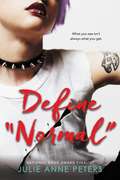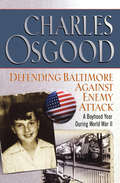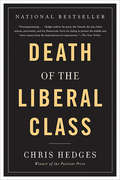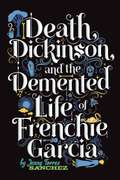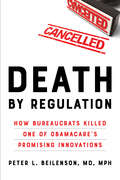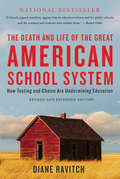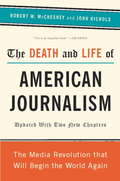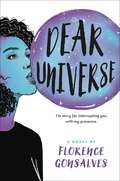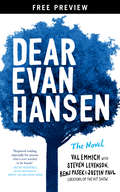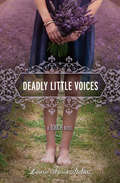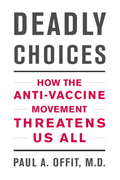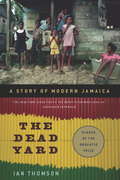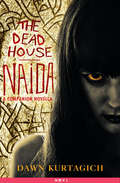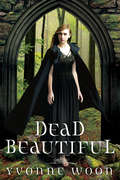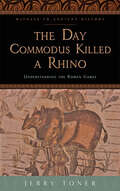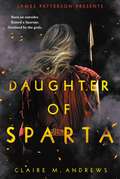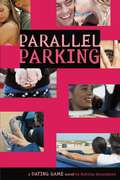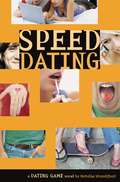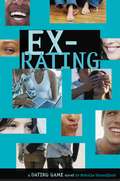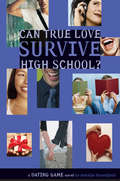- Table View
- List View
Define "Normal"
by Julie Anne PetersNow in its fourth hardcover printing, Define "Normal" has become a word-of-mouth phenomenon. This is a thoughtful, wry story about two girls--a "punk" and a "priss"--who find themselves facing each other in a peer-counseling program, and discover that they have some surprising things in common. A brand-new reading-group guide written by the author is included in the back of this paperback edition.
Defending Baltimore Against Enemy Attack: A Boyhood Year During World War II
by Charles OsgoodFrom beloved broadcaster Charles Osgood, a poignant memoir about one unforgettable childhood year during World War II. Defending Baltimore Against Enemy Attack is a gloriously funny and nostalgic slice of American life and a moving look at World War II from the perspective of a child far away from the fighting, but very conscious of the reverberations. With a sharp eye for details, Osgood captures the texture of life in a bygone era.
Defending Baltimore Against Enemy Attack: A Boyhood Year During World War II
by Charles OsgoodFrom beloved broadcaster Charles Osgood, a poignant memoir about one unforgettable childhood year during World War II.Defending Baltimore Against Enemy Attack is a gloriously funny and nostalgic slice of American life and a moving look at World War II from the perspective of a child far away from the fighting, but very conscious of the reverberations. With a sharp eye for details, Osgood captures the texture of life in a bygone era.
Death of the Liberal Class
by Chris HedgesThe liberal class plays a vital role in a democracy. It gives moral legitimacy to the state. It makes limited forms of dissent and incremental change possible. The liberal class posits itself as the conscience of the nation. It permits us, through its appeal to public virtues and the public good, to define ourselves as a good and noble people. Most importantly, on behalf of the power elite the liberal class serves as bulwarks against radical movements by offering a safety valve for popular frustrations and discontentment by discrediting those who talk of profound structural change. Once this class loses its social and political role then the delicate fabric of a democracy breaks down and the liberal class, along with the values it espouses, becomes an object of ridicule and hatred. The door that has been opened to proto-fascists has been opened by a bankrupt liberalismThe Death of the Liberal Class examines the failure of the liberal class to confront the rise of the corporate state and the consequences of a liberalism that has become profoundly bankrupted. Hedges argues there are five pillars of the liberal establishment – the press, liberal religious institutions, labor unions, universities and the Democratic Party— and that each of these institutions, more concerned with status and privilege than justice and progress, sold out the constituents they represented. In doing so, the liberal class has become irrelevant to society at large and ultimately the corporate power elite they once served.
Death of the Liberal Class
by Chris HedgesFor decades the liberal class was a defense against the worst excesses of power. But the pillars of the liberal class -- the press, universities, the labor movement, the Democratic Party, and liberal religious institutions -- have collapsed. In its absence, the poor, the working class, and even the middle class no longer have a champion. In this searing polemic Chris Hedges indicts liberal institutions, including his former employer, the New York Times, who have distorted their basic beliefs in order to support unfettered capitalism, the national security state, globalization, and staggering income inequalities. Hedges argues that the death of the liberal class created a profound vacuum at the heart of American political life. And now speculators, war profiteers, and demagogues -- from militias to the Tea Party -- are filling the void.
Death, Dickinson, and the Demented Life of Frenchie Garcia
by Jenny Torres SanchezIt is the summer after Frenchie Garcia's senior year, and she can't come to grips with the death of Andy Cooper. Her friends don't know that she had a secret crush on her classmate, and they especially don't know that she was with Andy right before he committed suicide. The only person who does know is Frenchie's imaginary pal Em (a.k.a. Emily Dickinson), who she hangs out with at the cemetery down the street.When Frenchie's guilt and confusion come to a head, she decides there is only one way to truly figure out why Andy chose to be with her during his last hours. While exploring the emotional depth of loss and transition to adulthood, Sanchez's sharp humor and clever observations bring forth a richly developed voice.
Death by Regulation: How Bureaucrats Killed One of Obamacare's Promising Innovations
by Peter L. BeilensonIn the contentious run-up to the passage of the Affordable Care Act, Congress passed a law to make nonprofit health insurance CO-OPs (formally known as Consumer Operated and Oriented Plans) a viable alternative to the public option. The idea was to create new competition in order to lower health insurance premiums and encourage innovation. Nearly two dozen such low-cost CO-OPs were launched in the wake of the ACA's passage; only four are in operation today.In Death by Regulation, Dr. Peter L. Beilenson tells the story of a group of Maryland-based public health professionals who launched the Evergreen Health Cooperative, only to discover that the ACA law encouraging CO-OPs was a "plastic plant"—a piece of legislation created for optics but never intended to be functional. Over most of its four years of existence, Evergreen succeeded against all odds, prevailing over naysayers, big insurance companies, Congress, and its founders' naïveté. But in an ironic twist, it was bureaucratic hostility from the Centers for Medicare and Medicaid Services—the very Obama administration agency responsible for the CO-OPs—that led to their collective demise.Beilenson traces the huge impact of seemingly small policy decisions on the work of his team and the people their CO-OP was built to serve. He recounts the excitement and satisfaction of launching such a valuable healthcare company, as well as the damage done to scores of employees and tens of thousands of satisfied healthcare customers when bureaucrats ran amok. The only book about these idealistic Obamacare CO-OPs and the obstacles they all faced, Death by Regulation offers an insider view of health policy and the reality of starting an insurance company from scratch.
Death by Regulation: How Bureaucrats Killed One of Obamacare's Promising Innovations
by Peter L. BeilensonIn the contentious run-up to the passage of the Affordable Care Act, Congress passed a law to make nonprofit health insurance CO-OPs (formally known as Consumer Operated and Oriented Plans) a viable alternative to the public option. The idea was to create new competition in order to lower health insurance premiums and encourage innovation. Nearly two dozen such low-cost CO-OPs were launched in the wake of the ACA's passage; only four are in operation today.In Death by Regulation, Dr. Peter L. Beilenson tells the story of a group of Maryland-based public health professionals who launched the Evergreen Health Cooperative, only to discover that the ACA law encouraging CO-OPs was a "plastic plant"—a piece of legislation created for optics but never intended to be functional. Over most of its four years of existence, Evergreen succeeded against all odds, prevailing over naysayers, big insurance companies, Congress, and its founders' naïveté. But in an ironic twist, it was bureaucratic hostility from the Centers for Medicare and Medicaid Services—the very Obama administration agency responsible for the CO-OPs—that led to their collective demise.Beilenson traces the huge impact of seemingly small policy decisions on the work of his team and the people their CO-OP was built to serve. He recounts the excitement and satisfaction of launching such a valuable healthcare company, as well as the damage done to scores of employees and tens of thousands of satisfied healthcare customers when bureaucrats ran amok. The only book about these idealistic Obamacare CO-OPs and the obstacles they all faced, Death by Regulation offers an insider view of health policy and the reality of starting an insurance company from scratch.
The Death and Life of the Great American School System: How Testing and Choice Are Undermining Education
by Diane RavitchAn urgent case for protecting public education, from one of America's best-known education expertsIn this landmark book, Diane Ravitch - former assistant secretary of education and a leader in the drive to create a national curriculum - examines her career in education reform and repudiates positions that she once staunchly advocated. Drawing on over forty years of research and experience, Ravitch critiques today's most popular ideas for restructuring schools, including privatization, the Common Core, standardized testing, the replacement of teachers by technology, charter schools, and vouchers. She shows conclusively why the business model is not an appropriate way to improve schools. Using examples from major cities like New York, Philadelphia, Chicago, Denver, and San Diego, Ravitch makes the case that public education today is in peril and includes clear prescriptions for improving America's schools.The Death and Life of the Great American School System is more than just an analysis of the state of play of the American education system. It is a must-read for any stakeholder in the future of American schooling.
The Death and Life of American Journalism: The Media Revolution That Will Begin the World Again
by Robert W McChesney John NicholsAmerican journalism is collapsing as newspapers and magazines fail and scores of reporters are laid off across the country. Conventional wisdom says the Internet is to blame, but veteran journalists and media critics Robert W. McChesney and John Nichols disagree. The crisis of American journalism predates the Great Recession and digital media boom. What we are witnessing now is the end of the commercial news model and the opportune moment for the creation of a new system of independent journalism, one subsidized by the public and capable of safeguarding our democracy.
The Death and Life of American Journalism: The Media Revolution That Will Begin the World Again
by Robert W. McChesney John NicholsDaily newspapers are closing across America. Washington bureaus are shuttering; whole areas of the federal government are now operating with no press coverage. International bureaus are going, going, gone. Journalism, the counterbalance to corporate and political power, the lifeblood of American democracy, is not just threatened. It is in meltdown. In The Death and Life of American Journalism, Robert W. McChesney, an academic, and John Nichols, a journalist, who together founded the nation's leading media reform network, Free Press, investigate the crisis. They propose a bold strategy for saving journalism and saving democracy, one that looks back to how the Founding Fathers ensured free press protection with the First Amendment and provided subsidies to the burgeoning print press of the young nation.
Dear Universe
by Florence GonsalvesA wildly witty and deeply profound chronicle of teenage anxiety and yearning, perfect for fans of Jesse Andrews and Robyn Schneider.It's senior year, and Chamomile Myles has whiplash from traveling between her two universes: school (the relentless countdown to prom, torturous college applications, and the mindless march toward an uncertain future) and home, where she wrestles a slow, bitter battle with her father's terminal illness. Enter Brendan, a man-bun-and tutu-wearing hospital volunteer with a penchant for absurdity, who strides boldly between her worlds--and helps her open up a new road between them.Dear Universe is the dazzling follow-up to Florence Gonsalves's debut, Love and Other Carnivorous Plants, hailed by School Library Journal as "a must-have sharp, powerful, and witty immersion into the complexities of . . . mental health."
Dear Evan Hansen: The Novel Free Preview Edition (The First Three Chapters)
by Val Emmich Steven Levenson Benj Pasek Justin Paul** INSTANT NEW YORK TIMES BESTSELLER **USA TODAY BESTSELLERWSJ BESTSELLERINDIE BOUND BESTSELLER From the show's creators comes the groundbreaking novel inspired by the hit Broadway show Dear Evan Hansen. Dear Evan Hansen, Today's going to be an amazing day and here's why...When a letter that was never meant to be seen by anyone draws high school senior Evan Hansen into a family's grief over the loss of their son, he is given the chance of a lifetime: to belong. He just has to stick to a lie he never meant to tell, that the notoriously troubled Connor Murphy was his secret best friend.Suddenly, Evan isn't invisible anymore--even to the girl of his dreams. And Connor Murphy's parents, with their beautiful home on the other side of town, have taken him in like he was their own, desperate to know more about their enigmatic son from his closest friend. As Evan gets pulled deeper into their swirl of anger, regret, and confusion, he knows that what he's doing can't be right, but if he's helping people, how wrong can it be? No longer tangled in his once-incapacitating anxiety, this new Evan has a purpose. And a website. He's confident. He's a viral phenomenon. Every day is amazing. Until everything is in danger of unraveling and he comes face to face with his greatest obstacle: himself.A simple lie leads to complicated truths in this big-hearted coming-of-age story of grief, authenticity and the struggle to belong in an age of instant connectivity and profound isolation.
Deadly Little Voices (A Touch Novel #4)
by Laurie Faria StolarzCamelia and Ben are two teens with the power of psychometry. But now Camelia has started to hear voices. Mean voices. Camelia receives frightening premonitions that someone's in danger. But who is the victim? And how can Camelia help them when she is on the brink of losing her own sanity?
Deadly Choices: How the Anti-Vaccine Movement Threatens Us All
by Paul A. OffitLearn how we can prevent dangerous diseases -- and why some deadly epidemics are making a comeback -- in this guide to science, vaccines, and life-saving knowledge from a medical expert.In 2014, California suffered the largest and deadliest outbreak of pertussis, also known as "whooping cough," in more than fifty years.This tragedy was avoidable. An effective vaccine has been available since the 1940s. In recent years other diseases, like measles and mumps, have also made a comeback. The reason for these epidemics can be traced to a group whose vocal proponents insist, despite evidence to the contrary, that vaccines are poison. As a consequence, parents and caretakers are rejecting vaccines for themselves and their families.In Deadly Choices, infectious-disease expert Paul Offit takes a look behind the curtain of the anti-vaccine movement. What he finds is a reminder of the power of scientific knowledge, and the harm we risk if we ignore it.
The Dead Yard: A Story of Modern Jamaica
by Ian ThomsonNamed the Dolman Travel Book of the Year, The Dead Yard paints an unforgettable portrait of modern Jamaica. Since independence, Jamaica has gradually become associated with twin images--a resort-style travel Eden for foreigners and a new kind of hell for Jamaicans, a society where gangs control the areas where most Jamaicans live and drug lords like Christopher Coke rule elites and the poor alike. Ian Thomson's brave book explores a country of lost promise, where America's hunger for drugs fuels a dependent economy and shadowy politics. The lauded birthplace of reggae and Bob Marley, Jamaica is now sunk in corruption and hopelessness. A synthesis of vital history and unflinching reportage, The Dead Yard is "a fascinating account of a beautiful, treacherous country" (Irish Times).
The Dead House: A Companion Novella
by Dawn KurtagichA digital short story from The Dead House author Dawn Kurtagich There is a box. A box that should never have been discovered. And a warning beneath the lid. This was for Kaitlyn. It was a mistake. Forget this box and leave the Isle. Don't look any further. I'm begging you. N.C.D. 2006After the inferno that swept through Elmbride High, claiming the lives of three teenagers and causing one student, Carly Johnson, to disappear, Naida Chounan-Dupre was locked away for the good of society.But that wasn't the end of the story. Because you can't play with the devil and not pay the price.The chilling, psychological horror of The Dead House returns with never-before-seen footage of the Naida tapes.
Dead Beautiful (A Dead Beautiful Novel #2)
by Yvonne WoonA compelling paranormal mystery about love...and death.On the morning of her sixteenth birthday, Renée Winters was still an ordinary girl. She spent her summers at the beach, had the perfect best friend, and had just started dating the cutest guy at school. No one she'd ever known had died. But all that changes when she finds her parents dead in what appears to be a strange double murder.After the funeral, Renée's wealthy grandfather sends her to Gottfried Academy, a remote and mysterious boarding school in Maine, where she finds herself studying subjects like Philosophy, Latin, and the "Crude Sciences." It's there that she meets Dante Berlin, a handsome and elusive boy to whom she feels inexplicably drawn. As they grow closer, unexplainable things begin to happen, but Renée can't stop herself from falling in love. It's only when she discovers a dark tragedy in Gottfried's past that she begins to wonder if the Academy is everything it seems—and if Dante is everything he seems.Dead Beautiful is both a compelling romance and thought-provoking read, bringing shocking new meaning to life, death, love, and the nature of the soul.
The Day Commodus Killed a Rhino: Understanding the Roman Games (Witness to Ancient History)
by Jerry TonerThe Roman emperor Commodus wanted to kill a rhinoceros with a bow and arrow, and he wanted to do it in the Colosseum. Commodus’s passion for hunting animals was so fervent that he dreamt of shooting a tiger, an elephant, and a hippopotamus; his prowess was such that people claimed he never missed when hurling his javelin or firing arrows from his bow. For fourteen days near the end of AD 192, the emperor mounted one of the most lavish and spectacular gladiatorial games Rome had ever seen. Commodus himself was the star attraction, and people rushed from all over Italy to witness the spectacle. But this slaughter was simply the warm-up act to the main event: the emperor was also planning to fight as a gladiator.Why did Roman rulers spend vast resources on such over-the-top displays—and why did some emperors appear in them as combatants? Why did the Roman rabble enjoy watching the slaughter of animals and the sight of men fighting to the death? And how best can we in the modern world understand what was truly at stake in the circus and the arena? In The Day Commodus Killed a Rhino, Jerry Toner set out to answer these questions by vividly describing what it would have been like to attend Commodus’ fantastic shows and watch one of his many appearances as both hunter and fighter. Highlighting the massive logistical effort needed to supply the games with animals, performers, and criminals for execution, the book reveals how blood and gore were actually incidental to what really mattered. Gladiatorial games played a key role in establishing a forum for political debate between the rulers and the ruled. Roman crowds were not passive: they were made up of sophisticated consumers with their own political aims, which they used the games to secure. In addition, the games also served as a pure expression of what it meant to be a true Roman. Drawing on notions of personal honor, manly vigor, and sophisticated craftsmanship, the games were a story that the Romans loved to tell themselves about themselves.
The Day Commodus Killed a Rhino: Understanding the Roman Games (Witness to Ancient History)
by Jerry TonerThe Roman emperor Commodus wanted to kill a rhinoceros with a bow and arrow, and he wanted to do it in the Colosseum. Commodus’s passion for hunting animals was so fervent that he dreamt of shooting a tiger, an elephant, and a hippopotamus; his prowess was such that people claimed he never missed when hurling his javelin or firing arrows from his bow. For fourteen days near the end of AD 192, the emperor mounted one of the most lavish and spectacular gladiatorial games Rome had ever seen. Commodus himself was the star attraction, and people rushed from all over Italy to witness the spectacle. But this slaughter was simply the warm-up act to the main event: the emperor was also planning to fight as a gladiator.Why did Roman rulers spend vast resources on such over-the-top displaysâ€�and why did some emperors appear in them as combatants? Why did the Roman rabble enjoy watching the slaughter of animals and the sight of men fighting to the death? And how best can we in the modern world understand what was truly at stake in the circus and the arena? In The Day Commodus Killed a Rhino, Jerry Toner set out to answer these questions by vividly describing what it would have been like to attend Commodus’ fantastic shows and watch one of his many appearances as both hunter and fighter. Highlighting the massive logistical effort needed to supply the games with animals, performers, and criminals for execution, the book reveals how blood and gore were actually incidental to what really mattered. Gladiatorial games played a key role in establishing a forum for political debate between the rulers and the ruled. Roman crowds were not passive: they were made up of sophisticated consumers with their own political aims, which they used the games to secure. In addition, the games also served as a pure expression of what it meant to be a true Roman. Drawing on notions of personal honor, manly vigor, and sophisticated craftsmanship, the games were a story that the Romans loved to tell themselves about themselves.
Daughter of Sparta (Daughter of Sparta #1)
by Claire AndrewsIn this thrilling reimagining of ancient Greek mythology, a headstrong girl does whatever it takes to rise up and become the most powerful fighter her people have ever seen.Seventeen-year-old Daphne has spent her entire life honing her body and mind into that of a warrior, hoping to be accepted by the unyielding people of ancient Sparta. But an unexpected encounter with the goddess Artemis—who holds Daphne's brother's fate in her hands—upends the life she's worked so hard to build. Nine mysterious items have been stolen from Mount Olympus and if Daphne cannot find them, the gods' waning powers will fade away, the mortal world will descend into chaos, and her brother's life will be forfeit.Guided by Artemis's twin—the handsome and entirely-too-self-assured god Apollo—Daphne's journey will take her from the labyrinth of the Minotaur to the riddle-spinning Sphinx of Thebes, team her up with mythological legends such as Theseus and Hippolyta of the Amazons, and pit her against the gods themselves.A reinterpretation of the classic Greek myth of Daphne and Apollo, Daughter of Sparta by debut author Claire Andrews turns the traditionally male-dominated mythology we know into a heart-pounding and empowering female-led adventure.
The Dating Game #6: Parallel Parking (The\dating Game Ser. #No. 6)
by Natalie StandifordMeet sophomores Madison, Holly and Lina. When the Dating Game Web site that they create for class becomes a campus hit, as a matchmaking service and a forum for students' views on love, sex, and dating, the three friends hope it will help them take control of their love lives, too?QUIZ: WHAT'S YOUR DATING STYLE?Check all the statements that sound like you._ I believe in love at first sight._ I always go after the hottest guy in the room._ I know I'm cute, and I expect the best. _ I never seem to like the one who likes me_ I like people no one else notices._ I believe you should love the one you're with._ My way or the highway!Holly, Lina, and Mads have mapped out a plan to definitely get the guys of their dreams. But are they moving too fast? Is it time to put the brakes on the ultimate search for love?
The Dating Game #5: Speed Dating (The\dating Game Ser. #Vol. 5)
by Natalie StandifordMeet sophomores Madison, Holly, and Lina. When the Dating Game Web site that they create for class becomes a campus hit, they become the matchmaking masters of their school, and they hope, their lives.
Dating Game #4: Ex-Rating
by Natalie StandifordThe Dating Game has gotten too hot to handle--at least for the school principal and parents. When a controversy erupts after exes begin rating each other, the Dating Game is banned from the school's computers. But Mads, Lina, and Holly aren't giving up without a fight.
Dating Game #3: Can True Love Survive High School? (The\dating Game Ser. #3)
by Natalie StandifordIs it True Love? (Circle the correct answer.) 1. You are dating an incredible boy named Stephen. He's good-looking, sexy, kind, funny, and smart. But you can't stop fantasizing about Sean, the hottest senior in school. Are you really in love with your boyfriend? Yes or No 2. You think about your high school teacher 24/7. You plot to hide in his bedroom closet and surprise him. Are you in love or out of your mind? In Love or Delusional 3. You and your boyfriend, Rob, spend Saturday nights playing video games, sharing pizza, and hanging out with his friends. Is this love or friendship? Boyfriend or Buddy 4. You meet a guy who makes your heart race and your knees weak. You are soul mates, the perfect match, cosmically meant for each other. You decide to bail high school and run away and marry him. Are you in love or brainless? In Love or Crazy Holly, Madison, and Lina are looking for true love. But how can you tell when it's real? What is true love anyway? For the answers, open this book and read on ... because Holly, Madison, and Lina are about to run smack into the truth about love!
